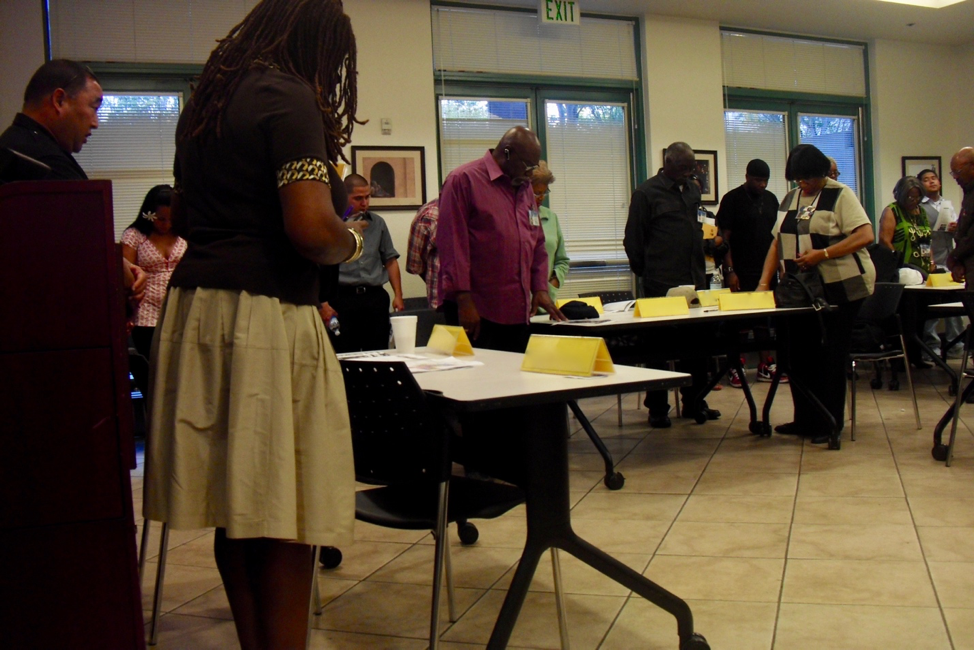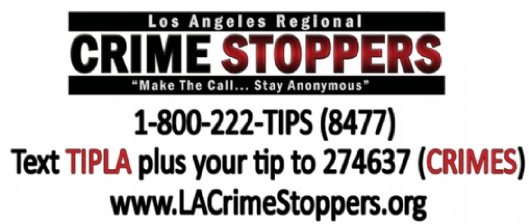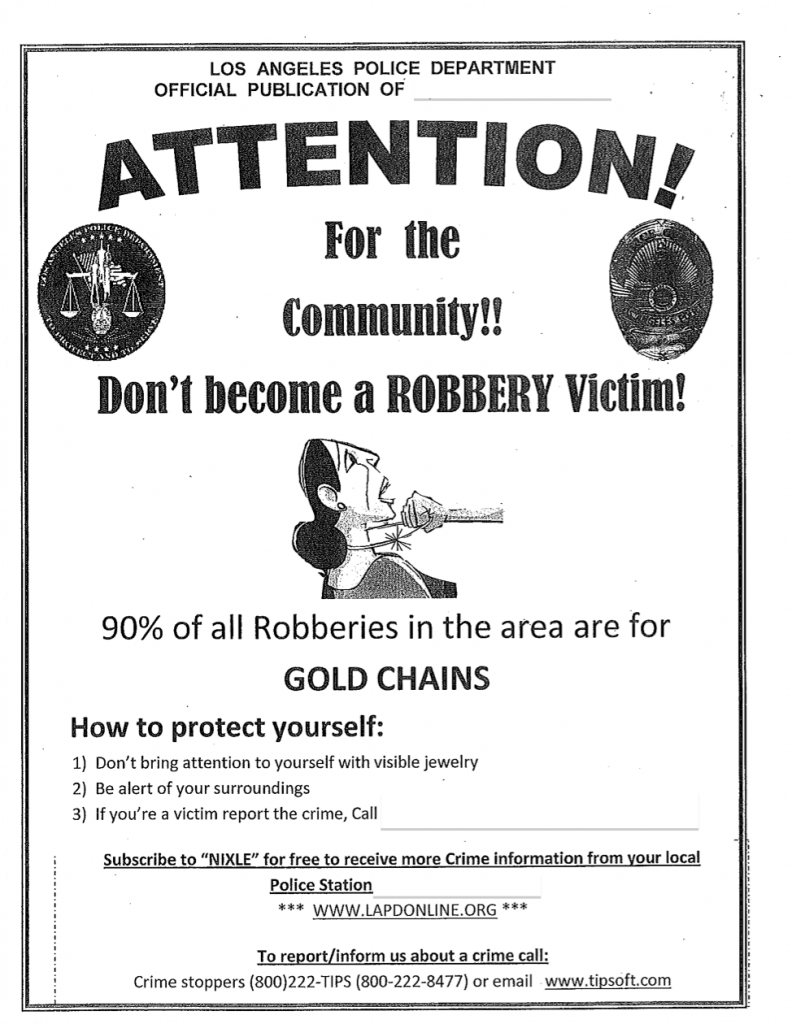
We bowed our heads in prayer to mourn yet another loss. It was the third murder in a week. The police captain called a meeting together to develop collaborative alternatives to enforcement so the mostly Black and Latino civilian volunteers could get more involved in promoting crime control. Lakeside, where I was conducting research, is in the heart of South LA’s “Black Belt”. The neighborhood is characterized by high rates of gang crime and violence, extreme poverty, widespread resentment toward police and is the site of the most destructive riots in US history. “We have to take our community back!” one meeting participant said as his voice cracked from the tears and frustration welling up inside him. Agreeing that something had to be done, the captain broke us into groups to spitball ideas. One popular idea was to canvass the affected neighborhood. Volunteers would pass out business cards and encourage residents to call with information about the shooting.

The cards that we handed out door-to-door were simple—bold lettering against a light background, the organization’s name and phone number, and a promise to protect anonymity—but they could also be socially impactful. Until then I was focused solely on power struggles in “community policing,” a post-riot policy that calls for greater civilian participation in law enforcement. Calling 9-1-1 is perhaps the clearest example of civilians “coproducing” social order. And canvassing with these cards only reinforced just how crucial civilian involvement is for law enforcement; their information and the lack thereof can directly shape case outcomes.

Then I started looking more closely at the cards and flyers that police and civilians passed around at community meetings. Visual rhetoricians look at textual and/or visual data and pick apart the “blocks of meaning” that authors arrange when composing documents such as flyers. Composition is a rhetorical act; its intention is to convince an audience. We can interpret these blocks on two registers, the presented and the suggested. The author presents a woman being robbed by an anonymous figure and frightened as a result. They explain how we, the audience, can change our daily routines to minimize our chances of being victimized and give us police contact information. Sociologist David Garland helps us see the suggested elements. He might point to this as an example of the new role of police as a key socializing institution, reflected here in the evocation of a specific outlook. Fear of crime today is at an all-time high; so high, in fact, that it far exceeds the realities of crime victimization in the US. This flyer gives us the sense, however, that crime is everywhere, every day, and that we ought to fulfill our civic responsibility to defend the community.
Drawing on over two years of ethnographic fieldwork and nearly two hundred documents, my new project, The Social Life of Flyers, seeks to understand what these artifacts do in community policing. Specifically, I seek to better understand the nature of flyers—their presented and suggested elements—and their bureaucratic functions beyond canvassing. My findings will reveal how police restrict rather than amplify civilian power in collaborative crime control. This work builds on my recently published coauthored book, The Limits of Community Policing, and can shape future ethnographic studies, research on police bureaucracy, and the craft of visual sociology.
Daniel Gascón is an assistant professor of sociology at the University of Massachusetts Boston. For more on his latest work, follow him on Twitter.

Comments 39
coca — November 5, 2019
The content is quite elaborate and detailed, but I think it needs more practical elements to attract the attention of readers, thank you for sharing this article.
boxnovel
resumeedge — November 5, 2019
Refine: You’ll have 7 days after receiving your first draft to request additional modifications. Finalize: Your completed, cover letter is delivered to you
pikachu chu — November 7, 2019
Thank you for your post. I have read through some similar topics! However, your article gave me a very special impression, unlike other articles. I hope you continue to have valuable posts like this or more to share with everyone!
driving directions
resume writer — November 20, 2019
A professional resume is now available, it will certainly attract attention and will not go unnoticed resume writer . Your best skills, experience will be collected at a high level. All the necessary information in one resume. And now you will succeed.
essay writer — February 2, 2020
I have passed my 10-week psychology class, and I'm thankful for the great essay writing help that Grademiners essay writing service provided through the 3 months or so. Any arising problems were addressed on time and my writer was fairly responsive in the course of completing my essays and discussion board posts. Will definitely hire their services for the next class.
coca — February 13, 2020
I really like your site and especially this post with lots of good and informative
mapquest directions
Anonymous — January 28, 2021
The police captain called a meeting together to develop collaborative alternatives to enforcement so the mostly Black and Latino civilian volunteers could get more involved in promoting crime control. https://cryptograph.life/statii/samye-perspektivnye-kriptovalyuty-dlya-investirovaniya-2
Anonymous — January 28, 2021
Composition is a rhetorical act; its intention is to convince an audience. We can interpret these blocks on two registers, the presented and the suggested. The author presents a woman being robbed by an anonymous figure and frightened as a result. They explain how we, the audience https://hashalot.io/blog/kak-upravlyat-fermoj-na-rasstoyanii-majner-i-os-nicehash/
Joshua Carbajal — April 21, 2021
Every single star highlight is accessible to use for nothing in Unity individuals. Solidarity Standard is on the off chance that you or your organization makes more than 100k per year. You need to take advice from business plan for a nightclub. This website is for business planning.
perterpan — August 12, 2021
I really enjoy your website, especially this post, which contains a lot of useful and interesting information.
run 3
Dragonrest — August 25, 2021
Nice explanation about flyers i hope you find about mp3 video download on dragonrest
friday nightfunk — January 25, 2022
find any address and route you want in mapquest directions
Adam Phelps — April 20, 2022
Getting dissertation help online is becoming increasingly common. I've always written my essays on my own since, like other students, I don't believe that essay writing is necessary. I enjoy writing essays on a variety of themes. I'm now working on thesis papers, and I'm finding them to be rather difficult. I need to hire a thesis assistant online because my thesis topic is quite difficult. One of my seniors suggested that I look at The Essay Pay' website. Choose their legal essay writing service and get professional help with thesis papers.
avtubehub — May 1, 2022
nonton bokep gratis berbagai bokep pilihan lengkap
TopEssayWriting — August 18, 2022
I don't think that these flyers have any social life they are just suffering from the worst behavior of our society, we must take some serious actions in order to protect their rights.
sara — September 23, 2022
Flyers have a social life too but just like to recommend that 247 exam help is offering the best online exam help services that can be best for academic needs.
Adam Dever — November 30, 2022
I can educate you to look for the assistance concerning proficient authors from the clinical individual data mining assignment solutions https://www.aussiessay.com/data-mining-assignment-help/. This will assist you with adapting to composed work of any intricacy in the most limited conceivable time without counterfeiting.
Mia Andrew — March 9, 2023
Thanks for sharing this informative content. Home insulation is an important aspect of maintaining a comfortable and energy-efficient living space. Insulation helps to regulate the temperature of your home, keeping it cool in the summer and warm in the winter. It also helps to reduce energy costs by preventing heat from escaping in the winter and cool air from escaping in the summer. In addition, insulation can also help to reduce noise levels and improve indoor air quality. There are various types of insulation available, such as fiberglass, cellulose, and spray foam, each with their own benefits and drawbacks. Choosing the right insulation for your home will depend on factors such as your budget, climate, and personal preferences. Regardless of the type of insulation you choose, proper installation is key to ensuring its effectiveness in reducing energy consumption and maintaining a comfortable living space.
Lincoln — March 18, 2023
This is the correct weblog for everyone who is would like to learn about this topic
Belinda — April 26, 2023
You can enjoy spanish dictionary + on your iPhone, iPad, and iPod touch by downloading it. Word and phrase speaker and translator from Spanish to English.
word wipe — May 23, 2023
A very interesting topic that I have been looking at, I think this is one of the most important information for me word wipe. And I'm glad to read your post. Thanks for sharing!
Hounda — October 23, 2023
I'd like further details. Action-adventure platformer pizza tower is described as having a retro aesthetic. The game has an original visual aesthetic and oddball comedy.
hitactress — February 2, 2024
nice blog
hitactress — February 2, 2024
thank you dear
hitactress
Jackson — June 3, 2024
Players can share the results of the online love tester on many social networking platforms, this helps each of us have an interesting and fun day, creating a topic to communicate more with each other.
Telegram中文版 — November 17, 2024
Telegram can serve as a vital tool for community engagement in Hong Kong. Like the volunteers in South LA's Lakeside neighborhood, communities in Hong Kong facing similar challenges could utilize Telegram groups to share information anonymously about incidents, coordinate neighborhood watch efforts, and foster trust among residents without the fear of direct confrontation.
Telegram中文版下载 — November 17, 2024
Telegram offers an efficient way to canvass neighborhoods digitally. Instead of physically distributing business cards as described in the article, Hong Kong volunteers could create Telegram channels for specific neighborhoods. These channels could serve as hubs for reporting incidents, sharing updates, and providing resources, enhancing collaboration between civilians and authorities
Telegram中文版下载 — November 17, 2024
Using Telegram ensures anonymity and safety in reporting crimes. In Hong Kong, where community trust can sometimes be strained, residents might feel safer reporting crime-related information via Telegram's secure platform. This could encourage more people to come forward, much like the outreach efforts in South LA aimed to rebuild trust and collaboration.
Sana Faris — January 25, 2025
One question that piques interest is "Do Flyers have a Social Life?" In a similar vein, Saudi Arabian students seeking CIPD certifications can profit from the experience of CIPD Assignment Writers Saudi Arabia, who will guarantee that their assignments are comprehensive, well-written, and in line with academic requirements for success.
iptv m3u — May 13, 2025
IPTV france m3u Entdecken Sie den besten IPTV Hd IPTV france m3u
Hd iptv — May 13, 2025
IPTV france m3u Entdecken Sie den besten IPTV Hd IPTV m3u france
Hd iptv — May 13, 2025
IPTV france m3u Entdecken Sie den besten IPTV Hd IPTV hd
Riliam — August 11, 2025
I'm particularly impressed by your analytical approach to the subject matter, drive mad 3 which is both logical and highly persuasive.
geometrygames — October 27, 2025
In today's society, any profession can live and maintain a stable life. Flyers profession will also have a good social life. geometry dash subzero
suhanan — October 31, 2025
In plants vs brainrots, developing a solid strategy is crucial for defending your garden against waves of pesky brainrots. Start by selecting seeds that offer strong offensive capabilities and are cost-effective to create a balanced lineup. As your plants grow, make sure to upgrade them regularly to enhance their power and defensive capabilities.
ben pascal — November 7, 2025
Do flyers have a social life? In a way, yes — many bird species, known as flyers, live in flocks, communicate through calls, and even cooperate while hunting or migrating. Just like how people share knowledge or faith through reading resources like Surah Mulk PDF, these creatures connect and interact in their own natural communities, showing that social bonds exist in all forms of life.
https://surahmulkpdf.net/
johnela — November 13, 2025
That’s a really interesting way to look at it — nature has its own version of community and connection. In the digital world, something similar happens with entertainment too. Platforms like Smart Play Full APK bring people together by offering movies, sports, and shows that everyone can enjoy anytime, anywhere.
Mitches — December 4, 2025
In snow road, you navigate their sleds through challenging terrains filled with obstacles.
jack ma — December 13, 2025
I didn’t expect the flyers to double as prayer cards, but that bold lettering veck stuck with me all day—felt like a quiet promise amid the sirens